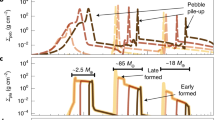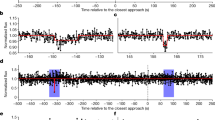Abstract
VOYAGER observations of the extended hydrogen exosphere of Uranus and of the σ Ring and its shepherds set an upper limit to the age of the σ Ring of 6 × 108 years. Unless we are seeing Uranus at a special time in its history, this requires a continuing process to create the ring material. We propose that the moons, rings and dust now visible in the Uranus system are created by the diminution of larger objects by meteoroid impacts. A Monte Carlo calculation shows that the largest surviving fragments of the original precursor satellites are in the size range of the new satellites observed by Voyager near the rings. The current bombardment rate is sufficient to create all the observed rings and dust bands. The observed and inferred components of the Uranus ring system fit a power-law size distribution with index of ∼3. We predict that the material in Neptune's ring system has a similar size distribution.
This is a preview of subscription content, access via your institution
Access options
Subscribe to this journal
Receive 51 print issues and online access
$199.00 per year
only $3.90 per issue
Buy this article
- Purchase on Springer Link
- Instant access to full article PDF
Prices may be subject to local taxes which are calculated during checkout
Similar content being viewed by others
References
Broadfoot, A. L. et al. Science 233, 74–79 (1986).
Goldreich, P. & Porco, C. C. Astr. J. 93, 730–737 (1987).
Porco, C. C. & Goldreich, P. Astr. J. 93, 724–729 (1987).
Peale, S. J. in Satellites (eds Burns, J. A. & Matthews. M. S.) 159–223 (University of Arizona Press, Tucson, 1986).
Smith, B. A. et al. Science 233, 43–64 (1986).
Cuzzi, J. N. & Burns, J. A. Icarus 74, 284–324 (1988).
Durisen, R. H. in Planetary Rings (eds Greenberg, R. A., Brahic, A.) 416–446 (University of Arizona Press, Tucson, 1984).
Grün, E., Zook, H. A., Fechtig, H. & Giese, R. H. Icarus 62, 244–272 (1985).
Plescia, J. B. J. geophys. Res. 92, 14,918–14,932 (1987).
Greenberg, R., Wacker, J. F., Hartmann, W. K. & Chapman, C. R. Icarus 35, 1–26 (1978).
Ockert, M. E., Cuzzi, J. N., Porco, C. C. & Johnson, T. V. J. geophys. Res. 92, 14969–14978 (1987).
Lane A. L. et al. Science 233, 65–70 (1986).
Lissauer, J. J., Squyres, S. W. & Hartmann, W. K. J. geophys. Res. 93, 13776–13804 (1988).
Sykes, M. V. & Greenberg, R. Icarus 65, 51–69 (1986).
Hartmann, W. K. Icarus 10, 201–213 (1969).
Burns, J. A., Showalter, M. R. & Morfill, G. E. 200–272. in Planetary Rings (eds Greenberg, R. & Brahic, A.) 200–272 (University of Arizona Press, Tucson, 1984).
Author information
Authors and Affiliations
Rights and permissions
About this article
Cite this article
Esposito, L., Colwell, J. Creation of the Uranus rings and dust bands. Nature 339, 605–607 (1989). https://doi.org/10.1038/339605a0
Received:
Accepted:
Issue Date:
DOI: https://doi.org/10.1038/339605a0
Comments
By submitting a comment you agree to abide by our Terms and Community Guidelines. If you find something abusive or that does not comply with our terms or guidelines please flag it as inappropriate.



